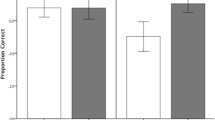Abstract
Reasoning-congruent representations help novices learn about the behavior of objects in a domain and provide a more profitable way for students to plan and implement solutions. We describe the use of visual representations in GIL, a tutor for LISP programming, and examine how this system implements the goals of a reasoning-congruent representation.
We are grateful to Assaf Bednarsh, Eliot Handelman, Daniel Kimberg, Marsha Lovett, Antonio Romero, Alka Tyle, and Chrys Wurmser for programming assistance. This research was supported by contracts MDA903-87-K-0652 and MDA903-90-C-0123 from the Army Research Institute, and grants from the James S. McDonnell Foundation and the Xerox Corporation University Grant Program. The views and conclusions contained in this document are those of the authors and should not be interpreted as necessarily representing the official policies, expressed or implied, of these institutions.
Preview
Unable to display preview. Download preview PDF.
Similar content being viewed by others
References
J. R. Anderson, C. F. Boyle, and G. Yost. The geometry tutor. Journal of Mathematical Behavior, 5:5–19, 1986.
P. Bayman and R. E. Mayer. Instructional manipulation of users' mental models for electronic calculators. International Journal of Man-Machine Studies, 20:189–199, 1984.
J. G. Bonar and R. Cunningham. Bridge: Tutoring the programming process. In J. Psotka, L. D. Massey, and S. A. Mutter, editors, Intelligent tutoring systems: Lessons learned, pages 409–434. Erlbaum, Hillsdale, NJ, 1988.
J. S. Brown. Process versus product: A perspective on tools for communal and informal electronic learning. Journal of Educational Computing Research, 1:179–202, 1985.
M. T. H. Chi, M. Bassok, M. W. Lewis, P. Reimann, and R. Glaser. Self-explanations: How students study and use examples in learning to solve problems. Cognitive Science, 13:145–182, 1989.
M. T. H. Chi, P. Feltovich, and R. Glaser. Categorization and representation of physics problems by experts and novices. Cognitive Science, 5:121–152, 1981.
A. Collins. Cognitive apprenticeship and instructional technology. In B. F. Jones and L. Idol, editors, Dimensions of thinking and cognitive instruction, pages 121–138. Erlbaum, Hillsdale, NJ, 1990.
B. du Boulay, T. O'Shea, and J. Monk. The black box inside the glass box: Presenting computing concepts to novices. International Journal of Man-Machine Studies, 14:237–249, 1981.
E. P. Glinert and S. L. Tanimoto. Pict: An interactive graphical programming environment. Computer, pages 7–25, 1984.
J. I. Heller and F. Reif. Prescribing effective human problem-solving processes: Problem description in physics. Cognition and Instruction, 1:177–216, 1984.
J. H. Larkin and H. A. Simon. Why a diagram is (sometimes) worth ten thousand words. Cognitive Science, 11:65–99, 1987.
D. McArthur, C. Stasz, and J. Y. Hotta. Learning problem-solving skills in algebra. Journal of Educational Technology Systems, 15(3):303–323, 1986.
B. J. Reiser, R. Beekelaar, A. Tyle, and D. C. Merrill. GIL: Scaffolding learning to program with reasoning-congruent representations. In The International Conference of the Learning Sciences: Proceedings of the 1991 conference, pages 382–388, Evanston, IL, 1991. Association for the Advancement of Computing in Education.
B. J. Reiser, D. Y. Kimberg, M. C. Lovett, and M. Ranney. Knowledge representation and explanation in GIL, an intelligent tutor for programming. In J. H. Larkin and R. W. Chabay, editors, Computer-assisted instruction and intelligent tutoring systems: Shared goals and complementary approaches, pages 111–149. Erlbaum, Hillsdale, NJ, 1992.
J. G. Trafton and B. J. Reiser. Providing natural representations to facilitate novices' understanding in a new domain: Forward and backward reasoning in programming. In Proceedings of the Thirteenth Annual Conference of the Cognitive Science Society, pages 923–927, Chicago, IL, 1991.
B. Y. White and J. R. Frederiksen. Causal model progressions as a foundation for intelligent learning environments. Artificial Intelligence, 42:99–157, 1990.
M. Yerushalmy and D. Chazan. Overcoming visual obstacles with the aid of the Supposer. Educational Studies in Mathematics, 21:199–219, 1990.
Author information
Authors and Affiliations
Editor information
Rights and permissions
Copyright information
© 1992 Springer-Verlag Berlin Heidelberg
About this paper
Cite this paper
Merrill, D.C., Reiser, B.J., Beekelaar, R., Hamid, A. (1992). Making processes visible: Scaffolding learning with reasoning-congruent representations. In: Frasson, C., Gauthier, G., McCalla, G.I. (eds) Intelligent Tutoring Systems. ITS 1992. Lecture Notes in Computer Science, vol 608. Springer, Berlin, Heidelberg. https://doi.org/10.1007/3-540-55606-0_14
Download citation
DOI: https://doi.org/10.1007/3-540-55606-0_14
Published:
Publisher Name: Springer, Berlin, Heidelberg
Print ISBN: 978-3-540-55606-0
Online ISBN: 978-3-540-47254-4
eBook Packages: Springer Book Archive




